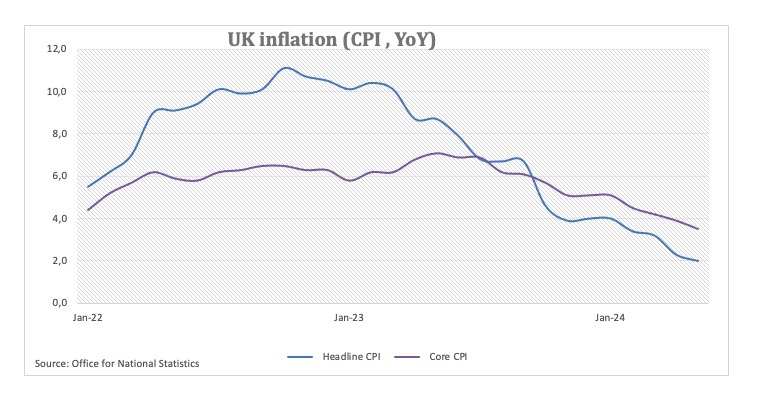The Bank of England (BoE) announced on Thursday that it left the policy rate unchanged at 5.25%, as widely expected. Seven policymakers voted to hold rates steady while Dave Ramsden and Swati Dhingra voted to cut rates by 0.25 percentage points.
Follow our live coverage of the BoE policy announcements and the market reaction.
BoE policy statement key takeaways
"June decision was finely balanced as higher-than-expected services inflation reflected factors that would not push up medium-term inflation."
"CPI to rise slightly in H2 2024 to around 2.5% as past falls of energy prices falls fade (May forecast: H2 CPI around 2.5%")."
"Labour market continues to loosen but relatively tight by historical standards."
"Staff forecast Q2 GDP +0.5% (May forecast: +0.2%), business surveys point to underlying quarterly growth of 0.25%."
"Key indicators of inflation persistence continue to moderate but remain elevated."
"Good news i inflation is back at 2%, need to be sure that inflation will stay low before cutting rates."
"Will keep under review for how long bank rate should be maintained at its current level."
"Will ensure bank rate is restrictive for sufficiently long to return inflation to the 2% target sustainably."
Market reaction to BoE policy decisions
GBP/USD edged lower with the immediate reaction and was last seen losing 0.25% on the day at 1.2690.
British Pound PRICE Today
The table below shows the percentage change of British Pound (GBP) against listed major currencies today. British Pound was the weakest against the Australian Dollar.
| USD | EUR | GBP | JPY | CAD | AUD | NZD | CHF | |
|---|---|---|---|---|---|---|---|---|
| USD | 0.12% | 0.25% | 0.21% | 0.03% | -0.03% | 0.05% | 0.58% | |
| EUR | -0.12% | 0.11% | 0.08% | -0.10% | -0.15% | -0.08% | 0.46% | |
| GBP | -0.25% | -0.11% | -0.04% | -0.21% | -0.26% | -0.19% | 0.33% | |
| JPY | -0.21% | -0.08% | 0.04% | -0.21% | -0.23% | -0.18% | 0.38% | |
| CAD | -0.03% | 0.10% | 0.21% | 0.21% | -0.07% | 0.02% | 0.55% | |
| AUD | 0.03% | 0.15% | 0.26% | 0.23% | 0.07% | 0.07% | 0.62% | |
| NZD | -0.05% | 0.08% | 0.19% | 0.18% | -0.02% | -0.07% | 0.53% | |
| CHF | -0.58% | -0.46% | -0.33% | -0.38% | -0.55% | -0.62% | -0.53% |
The heat map shows percentage changes of major currencies against each other. The base currency is picked from the left column, while the quote currency is picked from the top row. For example, if you pick the British Pound from the left column and move along the horizontal line to the US Dollar, the percentage change displayed in the box will represent GBP (base)/USD (quote).
This section below was published as a preview of the Bank of England rate decision at 07:00 GMT.
- The Bank of England is expected to keep its policy rate unchanged.
- UK disinflationary pressure accelerated in May.
- GBP/USD faces an initial up-barrier at 1.2860.
The Bank of England (BoE) is expected to keep its policy rate unchanged for the seventh consecutive meeting on Thursday, despite the recent acceleration of disinflationary pressures in the UK and speculation of two interest rate cuts this year.
Bank of England could deliver a cautious message
The Bank of England is widely seen maintaining its benchmark interest rate at 5.25% following its policy meeting on Thursday. In addition to the interest rate announcement, the central bank will release its Monetary Policy Minutes.
Despite disinflationary pressures remaining well in place in May, the Bank of England (BoE) appears poised to begin reducing its policy rate at some point in Q4 in response to still highly elevated services inflation (+5.7% YoY vs. +5.3% YoY expected in May).
Furthermore, inflation figures in the UK saw the headline Consumer Price Index (CPI) increasing by 2.0% (down from 2.3%) and the core CPI, which excludes food and energy costs, rising by 3.5% (down from 3.9%). Additionally, it was the first time that the CPI hit the bank’s goal since October 2021.

In addition, money markets now see around 45 bps of easing by the BoE by year-end and nearly 30 bps by November.
Regarding the upcoming event, the latest inflation readings are unlikely to challenge the BoE’s view of starting its easing cycle in the latter part of the year, while a cautious message, particularly highlighting services inflation and the still tight domestic labour market, should not be ruled out just yet.
All in all, the BoE is predicted to hold its policy rate at 5.25% on Thursday at 11 GMT. The vote is anticipated to stay 7-2, with a few revisions to the accompanying statement. It seems likely that traders will be particularly interested in rate recommendations for the August meeting. It is worth recalling that in its May policy decision, the central bank emphasised the importance of upcoming data in formulating decisions on monetary policy.
Following the bank’s event on May 9, Bank of England Governor Andrew Bailey stated that future rate cuts might need to exceed current market expectations to prevent inflation from dropping below target. On Thursday, Bailey remarked that even a small cut to the Bank of England's interest rate would keep monetary policy in restrictive territory.
Additional comments from BoE officials also saw outgoing Deputy Governor Ben Broadbent, whose final policy decision will be Thursday’s, reportedly maintain that there is a possibility of a summer rate cut. Broadbent indicated that for the BoE to justify lowering rates, the data would need to align with their projections. He also emphasized that he is giving more consideration to services CPI in the short term when making his decision.
His colleague Megan Greene, who had previously noted in April that high wage growth and services CPI indicated inflation persistence, making near-term rate cuts unlikely, has since adjusted her stance. Greene reportedly acknowledged that inflation persistence has lessened, thus omitting the earlier reference to distant rate cuts. Consequently, if forthcoming data further indicate that inflation is decreasing, markets might anticipate Greene voting for a rate cut at the June meeting, contributing to the dovish sentiment from the previous session.
Previewing the BoE gathering, Senior Macro Strategist at Rabobank Stefan Koopman argued that the BoE MPC is expected to maintain the policy rate at Thursday's meeting. "The vote might again be split, with two members possibly supporting a 25 bps rate reduction. While the MPC is considering lowering interest rates, the current data does not justify such a move. Additionally, the political context makes a pre-election rate cut unnecessarily complicated. We continue to believe that both wage growth and services inflation are not yet consistent with a sustained return to 2% inflation," he added.
How will the BoE interest rate decision impact GBP/USD?
Even though inflation continued to decline in May, the central bank is unlikely to adopt a more relaxed tone or provide a clearer indication of when interest rates might be reduced. With surprises largely ruled out, the British Pound (GBP) is expected to remain within its current familiar range for the time being.
Against that backdrop, GBP/USD maintains its constructive bias after convincingly surpassing the key 200-day SMA (1.2550). FXStreet Senior Analyst Pablo Piovano suggests that further gains may lead Cable to revisit the June high of 1.2860 (June 12). Beyond that, the next target is the 2024 top of 1.2893 (March 8) prior to the psychological milestone of 1.3000.
Conversely, Pablo notes that a resurgence of the selling bias could trigger some corrective moves in the short term. Immediate support aligns at the June low of 1.2656 (June 12), closely followed by the provisional 100-day and 55-day SMAs of 1.2639 and 1.2618, respectively. Down from here comes the 200-day SMA at 1.2550. A deeper pullback could put a potential test of the 2024 bottom of 1.2299 (April 22) back on the radar.
Pound Sterling FAQs
The Pound Sterling (GBP) is the oldest currency in the world (886 AD) and the official currency of the United Kingdom. It is the fourth most traded unit for foreign exchange (FX) in the world, accounting for 12% of all transactions, averaging $630 billion a day, according to 2022 data. Its key trading pairs are GBP/USD, aka ‘Cable’, which accounts for 11% of FX, GBP/JPY, or the ‘Dragon’ as it is known by traders (3%), and EUR/GBP (2%). The Pound Sterling is issued by the Bank of England (BoE).
The single most important factor influencing the value of the Pound Sterling is monetary policy decided by the Bank of England. The BoE bases its decisions on whether it has achieved its primary goal of “price stability” – a steady inflation rate of around 2%. Its primary tool for achieving this is the adjustment of interest rates. When inflation is too high, the BoE will try to rein it in by raising interest rates, making it more expensive for people and businesses to access credit. This is generally positive for GBP, as higher interest rates make the UK a more attractive place for global investors to park their money. When inflation falls too low it is a sign economic growth is slowing. In this scenario, the BoE will consider lowering interest rates to cheapen credit so businesses will borrow more to invest in growth-generating projects.
Data releases gauge the health of the economy and can impact the value of the Pound Sterling. Indicators such as GDP, Manufacturing and Services PMIs, and employment can all influence the direction of the GBP. A strong economy is good for Sterling. Not only does it attract more foreign investment but it may encourage the BoE to put up interest rates, which will directly strengthen GBP. Otherwise, if economic data is weak, the Pound Sterling is likely to fall.
Another significant data release for the Pound Sterling is the Trade Balance. This indicator measures the difference between what a country earns from its exports and what it spends on imports over a given period. If a country produces highly sought-after exports, its currency will benefit purely from the extra demand created from foreign buyers seeking to purchase these goods. Therefore, a positive net Trade Balance strengthens a currency and vice versa for a negative balance.
Information on these pages contains forward-looking statements that involve risks and uncertainties. Markets and instruments profiled on this page are for informational purposes only and should not in any way come across as a recommendation to buy or sell in these assets. You should do your own thorough research before making any investment decisions. FXStreet does not in any way guarantee that this information is free from mistakes, errors, or material misstatements. It also does not guarantee that this information is of a timely nature. Investing in Open Markets involves a great deal of risk, including the loss of all or a portion of your investment, as well as emotional distress. All risks, losses and costs associated with investing, including total loss of principal, are your responsibility. The views and opinions expressed in this article are those of the authors and do not necessarily reflect the official policy or position of FXStreet nor its advertisers. The author will not be held responsible for information that is found at the end of links posted on this page.
If not otherwise explicitly mentioned in the body of the article, at the time of writing, the author has no position in any stock mentioned in this article and no business relationship with any company mentioned. The author has not received compensation for writing this article, other than from FXStreet.
FXStreet and the author do not provide personalized recommendations. The author makes no representations as to the accuracy, completeness, or suitability of this information. FXStreet and the author will not be liable for any errors, omissions or any losses, injuries or damages arising from this information and its display or use. Errors and omissions excepted.
The author and FXStreet are not registered investment advisors and nothing in this article is intended to be investment advice.
Recommended content
Editors’ Picks

EUR/USD bounces off lows, retests 1.1370
Following an early drop to the vicinity of 1.1310, EUR/USD now manages to regain pace and retargets the 1.1370-1.1380 band on the back of a tepid knee-jerk in the US Dollar, always amid growing optimism over a potential de-escalation in the US-China trade war.

GBP/USD trades slightly on the defensive in the low-1.3300s
GBP/USD remains under a mild selling pressure just above 1.3300 on Friday, despite firmer-than-expected UK Retail Sales. The pair is weighed down by a renewed buying interest in the Greenback, bolstered by fresh headlines suggesting a softening in the rhetoric surrounding the US-China trade conflict.

Gold remains offered below $3,300
Gold reversed Thursday’s rebound and slipped toward the $3,260 area per troy ounce at the end of the week in response to further improvement in the market sentiment, which was in turn underpinned by hopes of positive developments around the US-China trade crisis.

Ethereum: Accumulation addresses grab 1.11 million ETH as bullish momentum rises
Ethereum saw a 1% decline on Friday as sellers dominated exchange activity in the past 24 hours. Despite the recent selling, increased inflows into accumulation addresses and declining net taker volume show a gradual return of bullish momentum.

Week ahead: US GDP, inflation and jobs in focus amid tariff mess – BoJ meets
Barrage of US data to shed light on US economy as tariff war heats up. GDP, PCE inflation and nonfarm payrolls reports to headline the week. Bank of Japan to hold rates but may downgrade growth outlook. Eurozone and Australian CPI also on the agenda, Canadians go to the polls.

The Best brokers to trade EUR/USD
SPONSORED Discover the top brokers for trading EUR/USD in 2025. Our list features brokers with competitive spreads, fast execution, and powerful platforms. Whether you're a beginner or an expert, find the right partner to navigate the dynamic Forex market.


